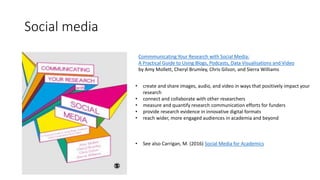Building a professional digital profile
- 1. Building a professional digital profile @lisaharris March 2019
- 2. Plan • Why do we need professional digital profiles? • Example tools • Blogging on Wordpress • Twitter • Slideshare • LinkedIn • Enhancing employability • Useful resources
- 3. Is the glass half empty? How can we be effective learners/researchers/professionals in a world where we are: • increasingly swamped with data • restricted by our filter bubbles to engaging with “people who are like us” • concerned about privacy issues, identity theft, fake news, trolling…?
- 4. Or is it half full? By actively developing and managing our digital footprint we can: • Keep up to date with developments in our field • Showcase our work for public engagement and impact purposes • Build our internal and external networks to “stand out from the crowd” and enhance career development • Engage with colleagues in creative ways • Collect research data and disseminate research findings • Promote “digital citizenship” • Building social capital with social media (video 3 mins)
- 5. The challenge A standard CV is no longer sufficient to stand out from the crowd in a global and rapidly evolving job market. “We are currently preparing students for jobs that don’t yet exist, using technologies that haven’t been invented, in order to solve problems we don’t even know are problems yet.” - Karl Fisch, “Did You Know” http://www.youtube.com/watch?v=YmwwrGV_aiE
- 7. Recruitment in a digital world According to a study by Jobvite: • 96% of recruiters use social media in the hiring process • 80% had been positively influenced by a candidate’s professional social network profile • 78% had been negatively influenced towards a candidate’s inappropriate use of social media • More input here from Southampton students on employer expectations
- 8. My Digital Profile Lisa Harris, Digital Educator. Connect via @lisaharris / L.J.Harris@exeter.ac.uk Finding me online: Twitter LinkedIn Slideshare Innovation in Education blog About.me HaikuDecks
- 9. Digital Literacies • effectively search for information and store the results. • evaluate the reliability of online information. • use editing, media-capture, communication and presentation tools. • collaborate and support others to participate effectively in online communities. • grow, manage and activate our networks effectively • present an appropriate online image and stay safe while doing so. • create and upload original material - such as by blogging or vlogging. • understand and respect the intellectual property rights of others
- 10. Digital Capabilities (JISC 2015) https://www.jisc.ac.uk/rd/projects/building-digital-capability
- 11. Active not Passive! • Active participation in relevant online social networks not only boosts reputation, it develops new digital skills in: • communication • information management • multimedia creativity • It’s a long-term strategy to develop a customised “digital footprint” • Building and managing this digital presence takes time and effort.
- 12. Free tools you may like to try • Appear.in for webinars • Googledocs for collaborative writing • Haiku Deck for cool image-based presentations • Piktochart for infographics • Biteable and Powtoon for cartoon videos
- 13. Blogging is key… • Current Exeter students: • The Digital Coffee House by Max Walkowiak • Julia Goes Digital by Julia Wilson • Lisanne’s Online Journey by Lisanne van den Brink • Navigating Work, Life and Play in the Digital Environment by Steven McRae • The role of blogging in building a career – from The Employable • How it all fits together – the Pervasive Professional Profile • Harris, L. and Rae, A. (2011) “Building a personal brand through social networking”, Journal of Business Strategy
- 14. Give before you receive • Developing a ‘digital footprint’ which demonstrates our skills is not an overnight task. Chris Brogan talks about ‘paying it forward’ – meaning we should give before we receive. • Long term benefit comes from focusing on the value we bring to our network, not what we take from it. • Don’t connect with someone on LinkedIn just when you need a recommendation. Share useful information with your network, and you will benefit when you need help in return. • Watch the discussion with my PhD students on paying it forward here
- 15. Questions for you… • Which social networks do you use professionally / for learning? What specific value do they provide to you? • Add your notes to this GoogleDoc to share with the group.
- 16. Social media Commmunicating Your Research with Social Media: A Practical Guide to Using Blogs, Podcasts, Data Visualisations and Video by Amy Mollett, Cheryl Brumley, Chris Gilson, and Sierra Williams • create and share images, audio, and video in ways that positively impact your research • connect and collaborate with other researchers • measure and quantify research communication efforts for funders • provide research evidence in innovative digital formats • reach wider, more engaged audiences in academia and beyond • See also Carrigan, M. (2016) Social Media for Academics
- 17. Another question for you… • In what ways will you enhance your professional digital profile after this session? • Add your notes to this GoogleDoc to share with the group.
- 18. More Resources • A detailed First Monday review of Facebook’s position on authenticity of identity • This BBC report discusses the nature of the “dark web” and the advantages and disadvantages that anonymity offers. • Harris, L. and Rae, A. (2011) “Building a personal brand through social networking”, Journal of Business Strategy • These two 30 minute BBC Four radio broadcasts explore the possibility of Online Identity Crisis and what online Authenticity involves.


















